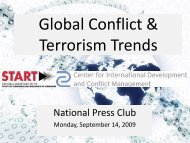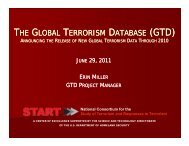Scientific Underpinnings of - START - National Consortium for the ...
Scientific Underpinnings of - START - National Consortium for the ...
Scientific Underpinnings of - START - National Consortium for the ...
You also want an ePaper? Increase the reach of your titles
YUMPU automatically turns print PDFs into web optimized ePapers that Google loves.
consequences <strong>of</strong> crisis on regional stability can help minimize <strong>the</strong> threat <strong>of</strong> instability. Through<br />
<strong>the</strong> analysis <strong>of</strong> multiple social science <strong>the</strong>ories, research methods, and established quantitative<br />
and statistical analysis techniques, this white paper, Perspectives on Political and Social<br />
Regional Stability Impacted by Global Crises - A Social Science Context, provides a significant<br />
step along <strong>the</strong> path to resolving <strong>the</strong> complex problems critical to <strong>the</strong> future security <strong>of</strong> <strong>the</strong> U.S.<br />
This edited volume, consisting <strong>of</strong> short contributions (5-7 pages each), will describe definitions<br />
<strong>of</strong> stability, will examine assessment approaches, and will extend to encompass strategies <strong>for</strong><br />
tailored assessment and planning.<br />
Clare Lockhart (Section 1) addresses <strong>the</strong> significance <strong>of</strong> “Stability and State Building.” This<br />
paper describes how functioning states are a vital piece <strong>of</strong> global architecture and that as such<br />
<strong>the</strong>y not only provide critical resistance to a variety <strong>of</strong> threats, but <strong>the</strong>y also contribute to <strong>the</strong><br />
collective global goals and stability in <strong>the</strong> 21 st century.<br />
Philip Martin <strong>of</strong> UC-Davis (2.1.A) reviews International Migration. The number <strong>of</strong> international<br />
migrants, defined by <strong>the</strong> UN as persons outside <strong>the</strong>ir country <strong>of</strong> origin a year or more, <strong>for</strong> any<br />
reason and in any legal status, more than doubled between 1990 and 2010. Current default policy<br />
is to manage what is <strong>of</strong>ten seen as out-<strong>of</strong>-control migration and by adjusting <strong>the</strong> rights <strong>of</strong><br />
migrants, leading to conflicts over human rights. Martin’s paper analyzes long-term factors<br />
affecting migration patterns, including aging in industrial countries, rural-urban migration that<br />
spills over national borders, and <strong>the</strong> migration infrastructure <strong>of</strong> agents and networks that moves<br />
people.<br />
Jack Goldstone (2.1.B) continues this <strong>the</strong>me with “Demography and Security,” in which he<br />
discusses <strong>the</strong> five major demographic trends likely to pose significant security challenges to <strong>the</strong><br />
majority <strong>of</strong> developed nations in <strong>the</strong> next two decades. He notes that problems will be caused not<br />
by <strong>the</strong> overall population growth, but by <strong>the</strong> population distortions, in which populations grow<br />
too young or too fast, or become too urbanized.<br />
In “Demographic Security,” Elizabeth Leahy Madsen (2.1C) reviews findings regarding<br />
population and two security issues—outbreaks <strong>of</strong> civil conflict and level <strong>of</strong> democratic<br />
governance—at <strong>the</strong> global scale. The <strong>the</strong>me <strong>of</strong> her paper is that population influences security<br />
and development, and it is an important underlying variable in global stability because <strong>of</strong> its<br />
interactions with o<strong>the</strong>r factors.<br />
David Richards and Ronald Gelleny (2.2.A) address <strong>the</strong> relationship between banking crises and<br />
domestic agitation/internal conflict in “Banking Crises, Collective Protest and Rebellion.” They<br />
examine a dataset <strong>of</strong> 125 countries <strong>for</strong> <strong>the</strong> years 1981 to 2000 and find banking crises to be<br />
systematically associated with greater levels <strong>of</strong> collective protest activities such as riots, antigovernment<br />
demonstrations, and strikes.<br />
An overview <strong>of</strong> work done at <strong>the</strong> Joint Staff J-5 is outlined by Peter Steen (2.2.B) in “Economics<br />
and Political Instability within <strong>the</strong> Global Economic Crisis.” This paper provides a strategic<br />
national-level understanding <strong>of</strong> <strong>the</strong> ongoing global economic crisis, as well as investigates <strong>the</strong><br />
relationship between economics and political instability within that context.<br />
Jerome Delli Priscoli (2.3.A) <strong>of</strong> <strong>the</strong> U.S. Army Corp <strong>of</strong> Engineers discusses <strong>the</strong> role <strong>of</strong> water and<br />
its relationship to international stability with “Water & Security: Cause War or Help Community<br />
Building.” He posits that <strong>the</strong> water and security debate is driven by our notions <strong>of</strong> scarcity, and<br />
7





